The Grand Sapphire of Louis XIV and The Ruspoli Sapphire
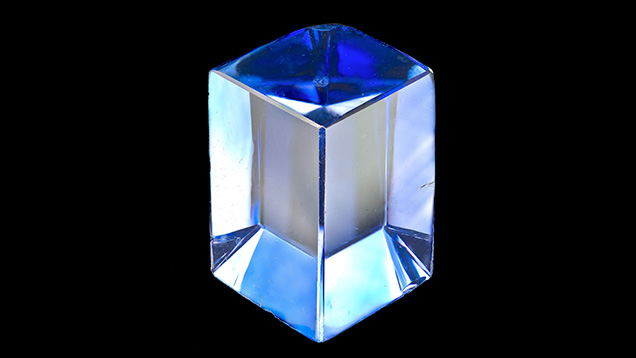
ABSTRACT
Since it was added to the French crown jewels in 1669, the 135.74 ct Grand Sapphire has been regarded as one of the world’s most magnificent sapphires. Newly discovered archives indicate that Louis XIV obtained the Grand Sapphire at about the same time he acquired the Tavernier Blue diamond; both gems were mounted in gold settings in 1672. Although the Grand Sapphire is often referred to as the “Ruspoli” sapphire, this study shows that these are, in fact, two different gems. Microscopic and spectroscopic evidence (Raman, UV-Vis-NIR absorption, and laser-induced fluorescence) suggest that the Grand Sapphire originated in the metamorphic/detrital terrain of Sri Lanka.
INTRODUCTION
Among the French crown jewels, four are preeminent. The 140.62 ct Regent and the 52.23 ct Grand Sancy diamonds (Balfour, 2009) are held in the Louvre Museum. The approximately 69 ct French Blue diamond was stolen in 1792 and recut to become what is now the Hope diamond (Farges et al., 2009; Post and Farges, 2014), housed at the Smithsonian Institution’s National Museum of Natural History. The 135.74 ct Grand Sapphire, shown in figure 1, was donated to the National Museum of Natural History (MNHN) in Paris in 1796 (Morel, 1988) and has remained there ever since.
Like the Grand Sancy and French Blue diamonds, the Grand Sapphire was added to the French crown jewels during the 72-year reign of King Louis XIV (Bapst, 1889). Morel (1988) reports that the gem was purchased from a merchant named Perret, who acquired it from a German prince, who bought it from the Ruspolis, an Italian noble family. This is how the gem also became known as the Ruspoli sapphire. Morel added that it once belonged to a poor Bengali spoon merchant, explaining its other nickname, the Wooden Spoon Seller’s sapphire.
While researching the historical archives for the French Blue diamond, we found no evidence of a jeweler named Perret serving Louis XIV. In fact, no such name is found among the registries of jewelers working in 17th century Paris (Bimbenet-Privat, 2002). Furthermore, no mention of the Ruspoli family surfaced until much later (Barbot, 1858); royal sources from the 17th and 18th centuries never refer to this origin. Because the connection between the Grand Sapphire and the Ruspolis appeared questionable, we conducted a thorough study of the French National Archives in Paris, along with the city’s archives, to better understand this confusing pedigree. We also performed an on-site gemological study, using portable instruments, to determine the Grand Sapphire’s physical properties. Due to the heightened precautions surrounding the preservation of the historical gemstone, this study was conducted in a single day, in the controlled confines of the MNHN, using portable spectrometers and complementary equipment. From the measurements obtained, we propose reasoned assumptions as to the geological and geographic origin of this famous sapphire.
BACKGROUND
The earliest dated documentation of the Grand Sapphire is the 1691 inventory of the French crown jewels (Bapst, 1889). The sapphire is described as a “violet sapphire,” “lozenge-shaped” and set in gold. Until the end of the 17th century, violet encompassed a color range from indigo blue to purple (Pastoureau, 2000). This range is consistent with the observed color, a medium blue with pale violet hues. The six-sided lozenge cut was rare for the 17th century (and even later). Its weight (“7 gros ½ et 12 grains,” equivalent to 28.74 g) is given with its gold setting. That year, the gem was appraised at 40,000 livres, the standard French currency at the time. On average, one livre in 1691 is roughly equivalent to US$15 in 2015 (based on the calculation by Allen, 2001).
In 1739, King Louis XV was inducted as a knight of the Order of the Golden Fleece (Farges et al., 2009). His jeweler, Pierre-André Jacqumin (or Jacquemin), was commissioned to create an insignia of that chivalric order. We recently discovered (Farges et al., 2008) that Jacqumin submitted two proposals: one with two main diamonds, including the French Blue (figure 2, left), and another with two large sapphires (figure 2, right). For the second version, the Grand Sapphire almost certainly would have been recut, as the king asked Jacqumin to use the existing crown jewels in the emblem (Morel, 1988). Because the king chose the diamond insignia, the sapphire was preserved, though its 1672 gold setting had disappeared: The sapphire is described without any gold setting in the 1774 royal inventory, kept in the French National Archives. Its weight is listed as 132 old Paris carats, equivalent to 135.18 ct (Morel, 1988). Like all the other jewels of the French Crown, the sapphire was kept within the Garde-Meuble (the royal storehouse), which is now the Hôtel de la Marine on Place de la Concorde in Paris. Hence, it was also known as the “saphir du Garde-Meuble.”
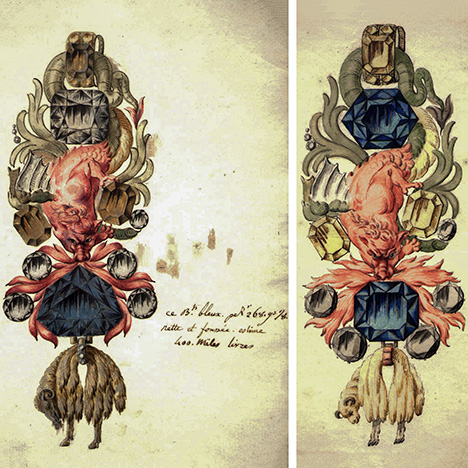
French crystallographer Jean-Baptiste Romé de l’Isle (1772) studied the unmounted sapphire and concluded that it was a natural, uncut gem. He even classified the Grand Sapphire as the most ideal crystal form for his fifth crystallographic system, the “rhombic parallelepiped” (figure 3). In the second edition of his Crystallographie, Romé de l’Isle (1783) seemed somewhat uncertain about his 1772 conclusion, writing that the gem’s facets might be related to human polishing. But Romé de l’Isle later received two crystal models of ruby shaped like the Grand Sapphire, causing him to reassert his original hypothesis (Romé de l’Isle, 1787). That same year, Mathurin Jacques Brisson published the stone’s density (equivalent to 3.9941 g/cm3, consistent with corundum), but stated that the stone’s shape was “most likely man-faceted” (Brisson, 1787). Despite this observation, the 1789 royal inventory (also kept in the National Archives) describes the sapphire as “not cut”; no appraisal is given. In 1791, another royal inventory now housed in the National Archives (Bion et al., 1791) characterized the sapphire as “a large chunk of sapphire, lozenge, six-sided, polished flat on all its facets. Two clear edges and rounded, bright and clear, weighing 132 k 3/16.” This was equivalent to 135.88 modern metric carats, with “k” representing old Paris carats. The sapphire’s value was appraised at one hundred thousand livres, roughly equivalent to US$1.5 million in 2015.
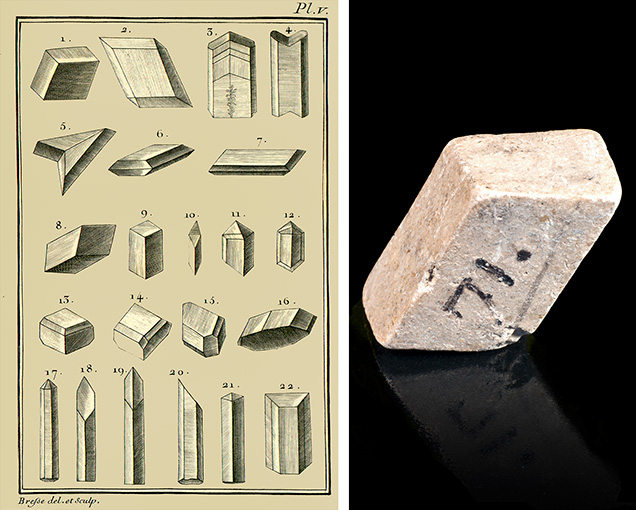
In September 1792, at the height of the French Revolution, rioters looted the royal treasury and stole most of the crown jewels, including the Regent, Grand Sancy, and French Blue diamonds. According to Morel (1988), the Grand Sapphire was not stolen. In the National Archives, however, we found an inventory completed immediately after the theft, which did not list any sapphires among the few remaining gems (Farges and Benbalagh, 2013). We therefore conclude that the sapphire also disappeared. A subsequent inventory from the Paris archives, dated December 23, 1792, contains the Grand Sapphire and other important sapphires of the French crown jewels (see box A). Presumably, these were recovered shortly after the looting, along with other notable gems, including the Peach Blossom and Hortensia diamonds (Bapst, 1889).
| BOX A: THE FRENCH CROWN JEWELS SINCE THE 1792 LOOTING |
| Soon after the looting of the royal storehouse, a first inventory was conducted on September 21, 1792. Officials established a loss of more than 95% of the treasure inventoried a year earlier (see Bion et al., 1791). But in October 1792, several of the thieves were identified. On his way to the guillotine, a man named Depeyron confessed (in exchange for his life) where he had hidden several large gems, including the Hortensia and one of the Mazarin diamonds (Bapst, 1889). As the investigation progressed, many jewels were eventually recovered. Inventories were thus regularly compiled to demonstrate that the police were conducting an efficient investigation. This is how the Grand Sapphire of Louis XIV resurfaced in December 1792. Eventually, the Grand Sancy and Regent diamonds were discovered during the spring of 1794. The only large gem never recovered was the French Blue, which was not considered as important as the colorless diamonds. Once most of the French crown jewels were recovered, a committee decided to contribute the pieces to various museums for the public’s benefit. Other royal collections were also dispersed, including artworks, precious books, and furniture. While jewels were assigned to the forthcoming Louvre museum, the Grand Sapphire was considered a mineral and thus went to the MNHN. When the French Empire was established in 1804, the crown jewels were reconstructed, with new acquisitions compensating for the 1792 losses. In 1887, the French government sold off most of the treasures, and only two dozen pieces were preserved for historical purposes. Most pieces were purchased by private collectors and companies such as Tiffany. Many gems were then dismounted, recut, or altered to a more modern taste. Today, France is attempting to recover the surviving pieces as part of its cultural heritage. Since 2014, the crown jewels donated to the MNHN have been displayed in a permanent exhibit, “Treasures of the Earth.” |
The Grand Sapphire was among the royal gems donated to the MNHN’s mineralogy gallery in 1796 (figure 4) for the purpose of “public education” (Morel, 1988), most likely because state officials accepted Romé de l’Isle’s belief that the sapphire was an uncut crystal. Louis Jean-Marie Daubenton, head professor of mineralogy at the MNHN, probably knew of the gem’s cut and prestigious pedigree (Morel, 1988). Indeed, his most distinguished scholar, René-Just Haüy (later regarded as the “father of modern crystallography”), soon recognized that the sapphire shape bore the “polish of art” (Haüy, 1801).
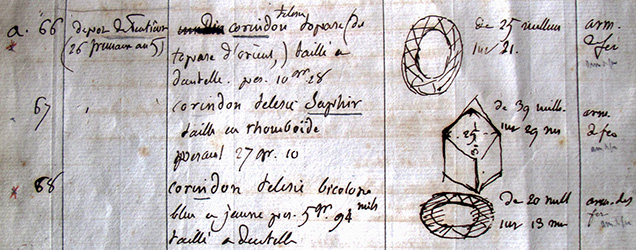
Since the sapphire’s acquisition by the museum, little has happened with it. Barbot (1858) wrote:
Then, Barbot added this previously unpublished information:
The first excerpt clearly refers to the Grand Sapphire. In the second excerpt, Barbot is the first to mention the sapphire’s previous owners, including the Bengali spoon seller, the Ruspolis (an Italian noble family misspelled by Barbot), a German prince, and finally Perret. Barbot also refers to “the famous trial” in which the gem was supposedly involved (which will be discussed at greater length). Since then, the Grand Sapphire has often been referred to as the “Ruspoli” (Simonin, 1867) or the Wooden Spoon Seller’s sapphire (Snively, 1872; Streeter, 1877; Tagore, 1879). The many inconsistencies in the gem’s narrative prompted us to reexamine those references, in order to better understand the historical, geographical, and geological origins of this extraordinary gem.
MATERIALS AND METHODS
Archives. We extensively investigated a series of unpublished documents uncovered in various locations, including the MNHN, the National Archives, the Paris city and departmental archives (Archives municipales and départementales), and the archives at the École Militaire and the National Library of France (BnF), all in Paris. We have also reviewed the diplomatic archives of the French Foreign Ministry in La Courneuve. This last search included the recently discovered books of royal gemstones (Livres des Pierreries du Roi), consisting of dozens of volumes produced between 1669 and 1789 and containing thousands of pages of unpublished information.
On-Site Experiments. Weight, goniometric, microscopic, and spectroscopic testing was conducted using portable instruments, as the sapphire was not allowed to leave the museum. These miniature instruments are well suited for examining highly valuable or oversized artifacts that cannot be transferred from the museum to a regular laboratory. The main limitation of portable instruments is their reduced specifications (low energy output, lateral resolution, and signal-to-noise ratio, among others) compared to larger versions of these instruments.
The analyses included Raman scattering spectroscopy using an Ocean Optics QE 65000 spectrometer, with 532 and 785 nm excitation lasers; near-ultraviolet to near-infrared (UV-Vis-NIR) spectroscopy with an Ocean Optics USB2000 spectrometer, covering a 350–1000 nm range with a spectral resolution of 1.5 nm (FWHM), using a tungsten lamp; and photoluminescence spectroscopy, induced by either a UV lamp (365 nm) or a continuous green laser operating at 532 nm excitation, all at ambient temperature. The fluorescence emission was collected with an optical fiber and analyzed by the Ocean Optics USB2000 spectrometer described previously (Panczer et al., 2013), using a UV lamp as the excitation source (254 and 365 nm, 6 W each). We also used a Marie Putois and Rochelle contact goniometer (from 1794), a binocular microscope (Krüss KSW4000 with 10× and 30× magnification), a Krüss GMKR10 professional refractometer with an LED source, and a Krüss GMKR13 polariscope.
Off-Site Experiments. For the items allowed to leave the exhibition gallery, such as the replica described below, 3-D laser scanning was performed at MNHN’s Surfaçus facility using a Konica Minolta Range 7 operating with a 660 nm laser (accurate to approximately 4 µm). Scanned data were reduced (edge-collapse decimation) using MeshLab, GemCad, and DiamCalc software packages for final adjustments of facets. Chemical analyses were performed with an SD3 Bruker solid-state X-ray detector (133 eV resolution) installed in a Tescan Vega II LSU scanning electron microscope operated in low-pressure mode (20 Pa) at 20 kV.
RESULTS AND DISCUSSION
The “Trial of the Sapphire.” In our archival search for a jeweler named Perret who might be involved in the story of the Grand Sapphire, only one match was found, from a trial conducted between 1811 and 1813 (Méjan, 1811; Berryer, 1839). A few months before the trial, Jean-François Perret purchased a large sapphire that allegedly once belonged to the Ruspoli family. He sold the gem to Milanese jeweler Antonio Fusi, who paid a deposit. A few days after this transaction, Fusi tried to cancel the sale and have his deposit refunded, but Perret refused. After the two-year trial, Fusi was ordered to pay Perret the balance due. To satisfy the judgment, the court seized the sapphire and sold it at auction in December 1813 (“Le procès du saphir,” 1813).
At the time of this trial, the Grand Sapphire had been kept at the MNHN for nearly 20 years. We found no evidence showing that this gem was sold by the MNHN before the trial and recovered later. Therefore, those pieces of information are contradictory. But Pierre-Nicolas Berryer, the lawyer who represented Perret, described this sapphire involved in the 1811–1813 trial as “of the purest sky blue, with an oval shape with symmetrical facets … much more magnificent than the well-known one of the royal storehouse; unique for its kind, it was priceless” (Berryer, 1839).
While Berryer failed to mention the gem’s weight, a legal expert named Maurice Méjan published an 1811 summary of recent trials, including that of the sapphire. Fortunately, Méjan recorded its weight as 133 old Paris carats (equivalent to 136.9 modern carats). Regardless, the shape and cut given by Berryer are not consistent with the Grand Sapphire. Notice, too, that Berryer compares the sapphire to one from “the royal storehouse,” the well-documented nickname of the Grand Sapphire prior to the 1792 looting (Farges and Dubois, 2013). In other words, Berryer considered the Grand Sapphire and the Ruspoli sapphire two distinct stones.
The Real Ruspoli Sapphire Rediscovered. In 2013, during a search of the National Library in Paris, we found a leaflet connected to the December 1813 court-ordered auction (inventory number SZ-1350). The leaflet claims that the sapphire was owned by a poor Bengali wooden spoon seller, the Ruspolis, and even Charlemagne, “who is believed to have received the gem from an Indian prince.” Yet there is no evidence within the document to support any of this. Therefore, we are skeptical of any historical provenance published in this leaflet, including the association with the Ruspoli family, and consider it the seller’s attempt to influence the price.
The auction leaflet shows a drawing of the sapphire involved in the trial (figure 5A). This drawing had to accurately represent the gem, which was on public display at the Hôtel Bullion in Paris a few weeks before the sale (“Le procès du saphir,” 1813). The stone depicted has a square cushion shape with rounded corners, brilliant faceting on the crown, and a step-cut pavilion. This drawing does not even remotely resemble the Grand Sapphire, but it does match Berryer’s 1839 description of the sapphire from the trial. The weight of this gem (136.9 ct when converted to metric carats) is close, but not identical, to that of the Grand Sapphire (135.74 ct). Therefore, the gem attributed to the Ruspolis in the auction leaflet is not the Grand Sapphire. Barbot clearly confused them in his 1858 treatise. How did this happen?

In 2012, we found a blue glass replica of a large gemstone in the MNHN drawers. Inventoried as no. 50.167, the replica is composed of a potassic lead glass (“strass”), according to SEM/EDX data, and doped with minor amounts of cobalt (approximately 0.2 wt.% CoO) that account for its vivid blue color. The 3-D model for this replica, obtained through laser scanning, is similar to the drawing of the Ruspoli sapphire (figure 5B, bottom). Its volume corresponds to a sapphire weighing 163 ct. The MNHN inventory, dated 1850 (but donated much earlier; see Farges et al., 2009), states:
|
Inv. no. |
Origin |
Description |
Location |
“Mr. Achard” is most likely David Achard, a Parisian jeweler from 1807 to 1831, who also donated the lead casts of the French Blue (MNHN inventory number 50.165) and another diamond (MNHN inventory number 50.166). Haüy (1817) named Achard the leading Parisian lapidary and jeweler. “Mr. Hoppe of London” is none other than Henry Philip Hope, for whom the Hope diamond is named (Farges et al., 2009).
The sale of the sapphire to Hope is confirmed by his catalogue of gems, compiled in 1839 by Bram Hertz, a prominent London jeweler. This inventory confirms the MNHN records: the drawing of his largest sapphire (figure 5C) is identical to the glass replica (MNHN inventory number 50.167; figure 5B). Also, Hertz’s 1839 drawing closely resembles the one from the 1813 auction leaflet (compare figures 5A and 5C). Furthermore, their weights correspond exactly with 532 grains (equivalent to 136.9 ct). Therefore, it would seem that Achard purchased the sapphire sometime after the 1813 auction and, before his death in 1831, sold the stone to Hope. At some point during this period, Achard donated the replica to the MNHN, where it was exhibited next to the Grand Sapphire in the same “Technological showcase No. 9” (described in Hugard, 1855). Our hypothesis is that Barbot examined both stones while visiting the MNHN’s gallery of mineralogy and confused them in his book.
Hertz (1839) describes Hope’s sapphire, now identified as the Ruspoli, as
The drawer mentioned above refers to a cabinet in which Hope stored his gem collection. The “wide plates” are a set of drawings for the most important gems from the collection, published by Hertz (1839) as an appendix to his inventory. Inside the tenth plate is the drawing of the sapphire (reproduced within figure 5C). Note that in Méjan (1811) and Hertz (1839), the weight of the sapphire remains unchanged at 532 grains, even though Paris and London used different units at the time. In other words, during his inventory of Hope’s largest sapphire, Hertz simply repeated the French weight from 1811 without reweighing it in London units.
Later Whereabouts of the Ruspoli Sapphire. Emanuel (1867) wrote that “in the Russian treasury are some [sapphires] of an enormous size, amongst them one of a light-blue tint, which formerly was in the possession of the late Mr. Hope.” Emanuel is most likely referring to the Ruspoli, easily the largest sapphire in Hope’s collection (Hertz, 1839). A portrait of Empress Marie Fyodorovna of Russia, housed at the Irkutsk Regional Art Museum, shows an impressive set of sapphire jewels. Among them is a squared sapphire in the center that could be the Ruspoli. Later, the stone was reset as the centerpiece of a sapphire and diamond kokoshnik (a Russian headdress) created by Cartier in 1909 and owned by the Grand Duchess Maria Pavlovna of Russia (Munn, 2001). The kokoshnik later belonged to Queen Marie of Romania (figure 6) and her daughter Ileana. The latter revealed that she sold the headpiece to a famous jeweler in New York around 1950 (Ileana, 1951) but did not give additional details on that transaction. Thus, the recent whereabouts of this kokoshnik and the Ruspoli sapphire are unknown. Although Ileana wrote that the sapphire weighed 124 ct, other sources indicate 137.2 ct (Munn, 2001) or even 137 ct (Nadelhoffer, 2007), values that closely correspond with the Ruspoli (136.9 ct).
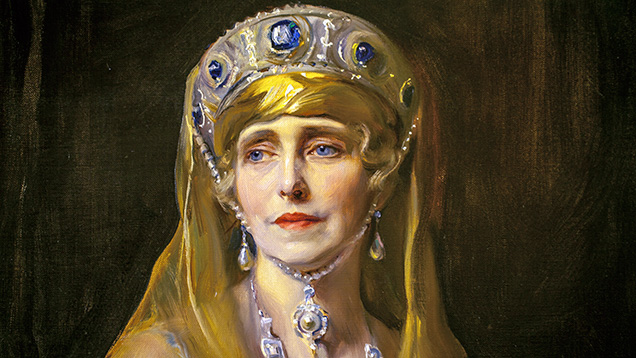
THE TRUE STORY OF THE GRAND SAPPHIRE
Supposedly purchased by Francesco-Maria Ruspoli (1672–1731; see Morel, 1988), the Ruspoli sapphire has a double series of crown facets that is more typical of the late 18th and early 19th century (Schrauf, 1869). In fact, there is no proof that this gem ever belonged to the Ruspolis, as jewelers and auction sellers often contrived aristocratic pedigrees and curse legends to increase gem values. Examples include the fake Spanish pedigree of the Wittelsbach Blue diamond (Dröschel et al., 2008) or the “curse” of the Hope diamond (Post and Farges, 2014). Charlemagne’s purchase of the Ruspoli sapphire from an Indian prince appears to be another such legend. Therefore, the name “Ruspoli” is highly questionable. A more accurate alternative would be the “Achard-Hope sapphire,” as this name is related to important personages actually involved with this historical gem.
For its part, the MNHN officially denies custody of the Ruspoli sapphire, claiming instead the Grand Sapphire of Louis XIV, the companion stone of the French Blue diamond.
The Acquisition of the Grand Sapphire. We searched the French royal archives to determine the exact provenance of the Grand Sapphire. In the Clairambault collection of the National Library of France, we discovered an unpublished financial record of royal expenses for gemstones, dated 1683. It lists a lozenge-cut sapphire worth 40,000 livres (see Farges and Benbalagh, 2013). This description is identical to the one given in the 1691 inventory for the Grand Sapphire. Because no other sapphire with such a shape and value is known, we conclude that this document deals with the acquisition of the Grand Sapphire. The 1683 record also provides a new piece of information: “the sapphire is not included in the purchases,” meaning that of all gemstones acquired by Louis XIV between 1661 and 1683, this is the only one for which no money was spent. Some pagination details in this archive (see Farges and Benbalagh, 2013) suggest that the acquisition was acknowledged during the spring or summer of 1669, but we do not know its exact circumstances.
Based on these dates, we examined the French Foreign Ministry archives, where the records of the royal gemstones are kept. Newly revealed documents for 1669 (French diplomatic archives, inventory number 2040) show that the Grand Sapphire was among the faceted sapphires inventoried by the royal treasurer on July 1, 1669 (Farges and Benbalagh, 2013). Here again, no information is given on the gem’s provenance. The inventory states that Jean Pittan the Younger, the king’s jeweler, was responsible for setting the sapphire in gold. Another record from the same archives, dated August 20, 1672, reports that the setting was completed and the sapphire was returned by Pittan. The weight of the jewel is listed as “7 gros ½ et 12 grains” (28.74 g), the same weight as in the 1691 inventory of the French crown jewels. Based on the current weight of the Grand Sapphire (135.75 ct), we estimate the weight of the pure gold setting to be around two grams. This is a curiously small amount of gold for such a large stone. The most plausible interpretation is that the Grand Sapphire was set on a stand composed of gold filigree, a style favored by Louis XIV (Bimbenet-Privat, 2002, 2003). Because of its mechanical properties, such an intricate network of gold wires could support the weight of a relatively large and heavy sapphire, despite the low weight of the metal itself.
We found nothing in those archives that explains how the sapphire was obtained other than the words “not included in the purchases.” This could mean a gift, plunder, inheritance, or deferred payment. We investigated these various possibilities (see Farges and Benbalagh, 2013) with no success. Since that study, one of the authors rediscovered the 1666 inventory of the French crown jewels (Farges, 2014a). This extensive manuscript does present important new information about the jewels, but none concerning the Grand Sapphire, suggesting that it had not yet entered the royal collection. Furthermore, nothing in the 1666 bequest of the Dowager Queen Anne of Austria or the record of the Russian diplomatic visit in 1668 provided fruitful hints. Also, there is no evidence of any gem purchase by Louis XIV between 1666 and February 1669, when gem merchants Jean-Baptiste Tavernier and David Bazeu (or Bazu) returned from their voyages to India (Morel, 1988). As the sapphire is not listed among the gems purchased from those merchants, the Grand Sapphire must have been obtained shortly after their return from India, but before its official recording in the royal books—in other words, between February and June 1669.
Analogies with the Tavernier Blue Diamond. Figure 7 shows the Grand Sapphire next to a cubic zirconia replica of the Tavernier Blue diamond that was cut and donated to the MNHN by Scott Sucher (see Sucher, 2009). The similarities between the Grand Sapphire and the Tavernier Blue, both acquired in 1669, are striking. They have roughly the same dimensions. The simple cuts and faceting allow the observer to easily study their purity, inclusions, and color (Farges, 2010).
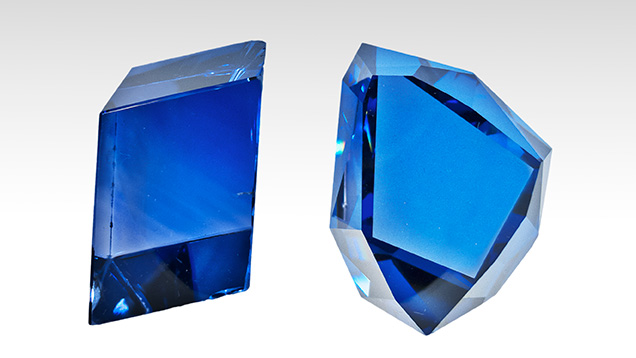
According to Zemel (2015), the Grand Sapphire is a Mogul-cut gem, like the Tavernier Blue diamond. Mogul-cut gems are often faceted irregularly or asymmetrically, usually showing a large flat base and an array of radial facets, as in the Orlov and Taj-i-Mah diamonds. Other Mogul cuts include more symmetrical shapes such as pendeloques or tables (the Darya-i-Noor diamond, for instance). Those diamonds were faceted in India during the 17th and 18th centuries, and cutters there were expert in minimizing weight loss during polishing (Tavernier, 1676). Louis XIV decided to recut the asymmetrical Tavernier Blue as an apparently symmetrical brilliant; the resulting stone became known as the French Blue. Clearly, the sapphire was already symmetrical, but the king did not ask for more ornate recutting (for instance, as a cushion with a step cut on its pavilion). If the Grand Sapphire is a Mogul cut, then either Tavernier or Bazeu must have donated it, as they were the only merchants to return from India in 1669 with gemstones (Morel, 1988). While Tavernier sold diamonds to Louis XIV, Bazeu also traded magnificent pearls and several colored gems, including two yellow sapphires and a red spinel, the latter also cut as a lozenge (Morel, 1988).
Despite the assertions of Morel (1988), Louis XIV never wore the Grand Sapphire or the Tavernier Blue diamond (Farges and Benbalagh, 2013). Instead, the gems were kept in a gold chest adorned with elaborate filigree, a masterpiece created for the king by Jacob Blanck, a little-known jeweler who worked for Jean Pittan the Younger (Bimbenet-Privat and Pié, 2014). Blanck’s creation is now known as the Louis XIV gemstone chest (“coffre des pierreries de Louis XIV,” inventory number MS 159). Bimbenet-Privat and Pié (2014) showed that the king used the chest to display his gemstones and royal ornaments to prestigious visitors, just as the Mogul emperor Aurangzeb had with Tavernier in 1665 (Tavernier, 1676).
The acquisition of two large blue gems at about the same time (the spring of 1669) is no coincidence. Around 1672, both gems were set into gold, which was out of the ordinary for the French Court. In fact, most of the diamonds in the French crown jewels were set in silver-plated gold, which was considered more valuable at the time (Bimbenet-Privat, 2002). Therefore, the setting of both blue gems into gold is atypical of this period and could be a reference to the “azure and gold” colors of the French monarchy (Pastoureau, 2000).
GEMOLOGICAL STUDY
We used the following orientation to identify the facets of the sapphire (again, see figure 1). “Top” is the upper horizontal, nearly square facet. “Front left” and “front right” are the two main frontal facets seen in figure 1, while the left rear, right rear, and bottom facets are not visible. There is a missing corner on the upper rear area of the sapphire, at the junction of the left rear, right rear, and top facets.
Visual examination of the Grand Sapphire shows that its blue color is not uniform; rather, it displays chevron-pattern zoning. The observed color is a medium blue with pale violet hues ranging from violetish blue to pure blue, with a medium to medium-dark tone and a strong saturation. The gem reveals abundant evidence of rough handling, containing many scratches, nicks, and pits. It weighs 27.148 grams (135.74 ct).
Shape. The dihedral angles of the Grand Sapphire rhomboid are 75°, 90°, and 71°. Its shape has nothing in common with a rhombohedron (whose dihedral angles are 75.5 or 76°). The shape is a parallelepiped, with two axes intersecting at oblique angles and a third orthogonal to the two other axes. Four edges are slightly recut, connecting the three front facets seen in figure 1 (as well as another edge on the upper left rear), while the other eight edges are actually quite sharp. On the upper rear, one significant missing corner shows a flat surface of a few square millimeters (figure 8A). This surface forms angles of 105°, 85°, and 105° with its three neighboring facets. The texture of this surface contrasts with the other facets of the gem. Closer microscopic examination reveals many imperfections such as micron-size cavities around approximately circular frosted areas that are much duller (figure 8A). Also, this surface lacks crystalline patterns such as the terraces that are typical of the naturally formed crystal habit of sapphire (see figures 8B and 8C). The irregularities observed suggest some abrasive polishing by water action. This might indicate that the Grand Sapphire was recut from a larger piece of sapphire found in weathered alluvial gravels, typical of corundum in Sri Lanka (see, among others, Hughes, 1997). If the Mogul origin of this faceting is confirmed (see Zemel, 2015), one can speculate that this rough was only slightly larger than the cut gem (see Tavernier, 1676), confirming Haüy’s observation (1801) that the sapphire was cut “to preserve its volume as much as possible.”
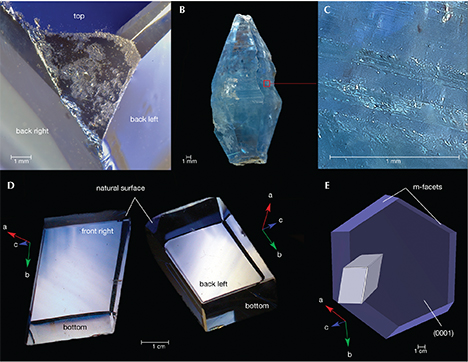
Orientation. A plane polariscope was used to better observe the chevron-patterned zoning of the Grand Sapphire (figure 8D). These chevrons correspond to the growth pattern of two of the six facet planes of the hexagonal corundum crystal (i.e., the m-planes of the hexagonal lattice system of the trigonal crystal system: [1100], [0110], [1010], [1100], [0110], and [1010]). Using the polariscope, the direction of the c-axis was determined thanks to its total extinction (sapphire is uniaxial negative). The color zoning appeared in high contrast when set 15–20° off-axis. In the pictures taken from this direction (figure 8D), the apparent angle of the chevrons is approximately 125° (close to the theoretical value of 120° for a trigonal/hexagonal crystal-like sapphire). This confirms the previous determination of the crystal orientation using the polariscope. Otherwise, the apparent angle would be much larger from other viewing angles and the chevrons would not be visible when the viewing angle was too far from the c-axis. Using GemCad, we created a 3-D model of the Grand Sapphire based on direct goniometric measurements. This model is set in an orientated hexagonal preform (figure 8E) to illustrate how the gem represented a small portion of the original crystal (assuming it crystallized isotropically) before it was smoothed by erosion.
Refraction. The Grand Sapphire’s refractive indices are 1.772 (nω) and 1.764 (nε). The gem is uniaxial negative, with a birefringence of 0.008. These values are consistent with corundum (see Bariand and Poirot, 1985).
Inclusions. We observed oriented rutile needles (figure 9) and a globe-shaped opaque black inclusion with highly reflective surfaces and a high refractive index. The opaque black inclusion resembles an iron oxide such as hematite or ilmenite.
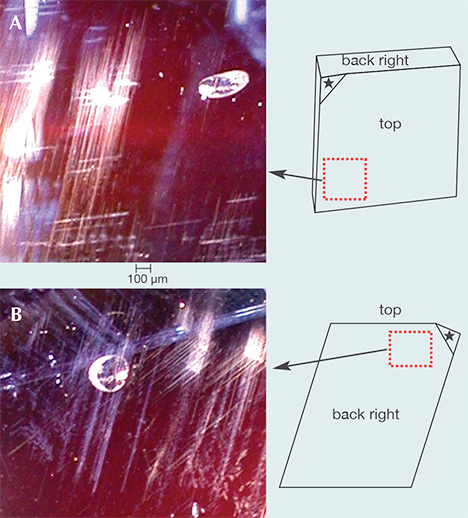
Fluorescence. The Grand Sapphire showed moderate red fluorescence under long-wave UV (365 nm) illumination, but weaker fluorescence under short-wave UV (254 nm). Moreover, its fluorescence was a more intense red along the green 532 nm laser beam through the stone (figure 10).
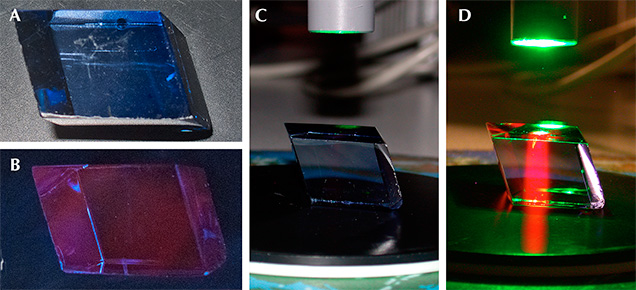
Raman Scattering Spectroscopy. Raman spectra collected with 532 and 785 nm laser excitation were comparable (figure 11). With 785 nm excitation, the baseline was not uniform, most likely due to the gem’s fluorescence in the Raman range (Panczer et al., 2012). In both cases, clearly detected Raman scattering peaks corresponded to their associated vibration modes (Al-O bonds in a six-fold octahedral coordination).
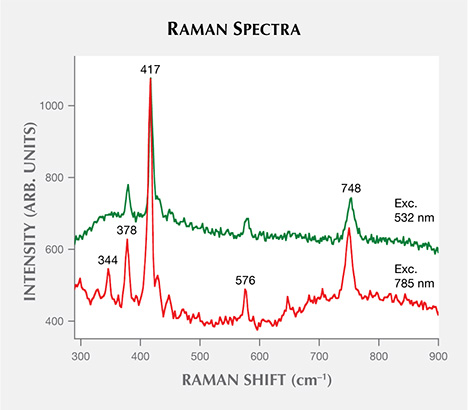
UV-Vis-NIR Spectroscopy. Three zones of the gem were selected for UV-Vis-NIR spectroscopy (figure 12). One zone corresponded to the central part of the sapphire. The second and third zones had the highest and lowest color saturation, respectively. The spectra for the three zones were comparable. An absorption band was detected in the green to red spectral range for all zones, with a maximum centered near 576 nm. A more narrow absorption contribution, though less intense, was observed near 450 nm. Also, a negative-intensity line corresponded to an emission peak at 694 nm (again, see figure 12).
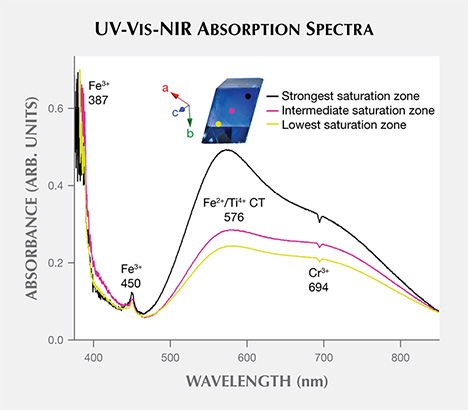
Luminescence Spectroscopy. Luminescence spectroscopy, induced by either a 365 nm UV source or by a 532 nm continuous laser, showed a sharp, intense emission line at 694 nm (figure 13). This phenomenon indicated that the two wavelengths excited an extrinsic luminescent center whose electrons were subjected to a radiative transition—in this case, the presence of Cr3+ atoms. The portable apparatus used did not discriminate between the transitions related to Cr3+ (referred to here as R1 and R2, centered at 692.9 and 694.3 nm, respectively; Gaft et al., 2015). The other weak bands observed in the spectra are secondary peaks related to the main doublet (Panczer et al., 2013). These results also explain the negative absorption measured by UV-Vis-NIR spectroscopy near 694 nm, as seen in figure 12.
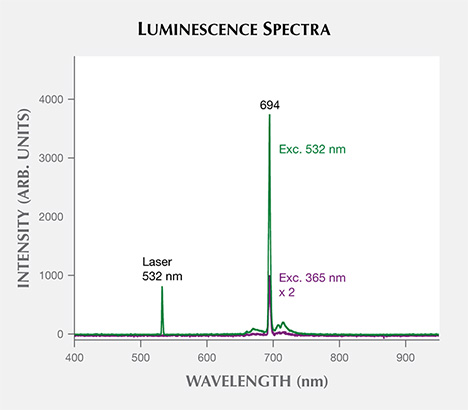
Interpretation. Despite the use of portable instruments with lower resolution than laboratory or synchrotron-based instruments, the gem shows the physical properties of a sapphire. Its Raman scattering spectrum (again, see figure 11) matched that for corundum from the RRUFF database. The rutile inclusions were not weathered or dissolved. Therefore, the Grand Sapphire did not undergo any thermal treatment above 1600°C. Its optical absorption showed a maximum at 576 nm, consistent with an electron exchange between Fe2++ Ti4+ and Fe3++ Ti3+ (Ferguson and Fielding, 1971; Fritsch and Rossman, 1988). The 694 nm “negative” absorption peak seen in figures 12 and 13 was related to the presence of Cr3+ substituting for six-fold coordinated Al3+ (high crystal field) in corundum (Gaft et al., 2005; Panczer et al., 2012) and was responsible for the narrow and intense red emission. Cr3+ is a frequent impurity in corundum, including sapphires (Bariand and Poirot, 1985).
Geological and Geographical Origins. Determining the geologic or geographic origin of sapphire remains a challenge even with advanced analytical methods (Mumme, 1988; Notari and Grobon, 2002; Shigley et al., 2010). For instance, blue sapphires from Sri Lanka and Madagascar show similar mineralogical and gemological properties (Gübelin Gem Lab, 2006). However, the determination of geographical origin of a rare historical gemstone such as the Grand Sapphire is based on limited but convergent criteria (inclusions, growth zones, absorption patterns, luminescence, and the like). In addition, the number of possible geographical occurrences for the Grand Sapphire is historically limited: The only active deposits before 1669 were in modern-day Myanmar, Sri Lanka, and Thailand-Cambodia. The rutile inclusions observed in Burmese sapphires are usually shorter and more densely packed (see Hughes, 1997) than those observed in the Grand Sapphire, which appear more typical of Sri Lanka (L. Thoresen, pers. comm., 2015).
According to the Gübelin Gem Lab (2006), the Grand Sapphire’s UV-Vis-NIR spectrum is typical of sapphires that crystallized in metamorphic rocks. Their absorption is dominated by an intense Fe2+/Ti4+ charge transfer, with absorption maxima centered at 575 and 700 nm. The absorption bands related to Fe3+ are usually weaker (Hughes, 1997). Therefore, the Grand Sapphire probably originated from the charnokitic series (an orthopyroxene-bearing metamorphic rock with granitic composition) of Sri Lanka or their fragmented clastic (detrital) sediments, as suggested by the examination of the small natural, uncut facet of the Grand Sapphire. The use of a laboratory UV-Vis-NIR apparatus should not affect the conclusions drawn from luminescence spectroscopy, as the charge transfer bands of interest are well probed with sufficient resolution by the portable apparatus. This study therefore shows how portable instruments, despite their intrinsic limitations, can assist with the examination of museum pieces that cannot be transferred to a laboratory setting.

CONCLUSION
Through a historical and gemological study of the Grand Sapphire, we have rediscovered some of its lost secrets. The stone is likely from Ceylon, present-day Sri Lanka. It may have been cut originally by Indian lapidaries (Zemel, 2015) before being purchased by a European (possibly David Bazeu) and given to Louis XIV around 1669, about the same time the monarch purchased the Tavernier Blue diamond. Both gems were set in gold under the supervision of jeweler Jean Pittan the Younger at about the same time (1672–1673). A gold setting was used, possibly to highlight the “azure and gold” colors of the French monarchy (Farges, 2010; Post and Farges, 2014). There is no evidence that Louis XIV ever wore those gems as part of his regalia. Instead, the gems were placed in a remarkable gold chest that was exhibited to impress selected visitors (see Farges, 2010; Bimbenet-Privat and Pié, 2014: Post and Farges, 2014).
The faceting of the Grand Sapphire is relatively simple but remarkable nonetheless. Recutting it as a cushion would have resulted in significant weight loss with no dramatic increase in brilliance. In this regard, Louis XIV proved to have eclectic tastes, collecting both minimally faceted (possibly Mogul) gems such as the Grand Sapphire and complex brilliant-cut faceted gems such as the French Blue, one of the first brilliant-cut diamonds ever documented (Farges, 2014b).
In 1739, the sapphire was removed from its gold setting, most likely to consider recutting it into two stones for Louis XV’s Order of the Golden Fleece insignia. Fortunately, this idea was eventually abandoned. Sometime between 1739 and 1774, the Grand Sapphire became an object of scientific study; M.J. Brisson measured its density, while Jean-Baptiste Romé de L’Isle examined its shape and eventually concluded that it was an uncut crystal. From the crystal, Romé de L’Isle shaped a model in bisque (1772). Apparently stolen in September 1792 and recovered a few months later, the sapphire entered the national collection of mineralogy at the MNHN in Paris, where Haüy (1801) once again identified it as a faceted gem.
Since 1858, the Grand Sapphire has often been confused with another gem, known as the Ruspoli sapphire, for which the MNHN possesses a historical replica that was once exhibited near the Grand Sapphire. The stones have approximately the same weight, but their faceting is dramatically different. Whereas the Grand Sapphire is a six-sided “lozenge” cut, the Ruspoli is a more conventional cushion cut. This sapphire was then sold at an auction in 1813 and acquired by the French jeweler David Achard, who subsequently sold it to Henry Philip Hope. Czar Nicholas I is said to have obtained the stone, which may have adorned a great Russian kokoshnik designed in 1909 by Cartier. Princess Ileana of Romania sold the piece to a jeweler in the United States in the 1950s, and its current whereabouts are unknown.
Unearthing elements of the true story of the Grand Sapphire reaffirms its rightful standing as one of the most important gemstones of the 17th century. Its unusual shape makes it one of the singular cut stones of all time. It is celebrated in a permanent exhibit named “Treasures of the Earth” (Trésors de la Terre), which opened in December 2014 at the MNHN. This exhibit places the sapphire in its appropriate context with the other magnificent gems and art objects of the French crown jewels.



